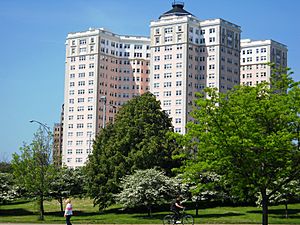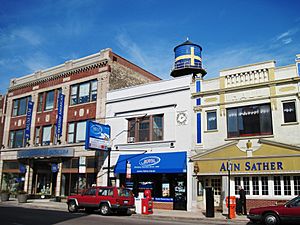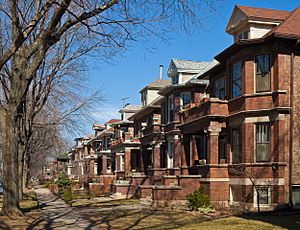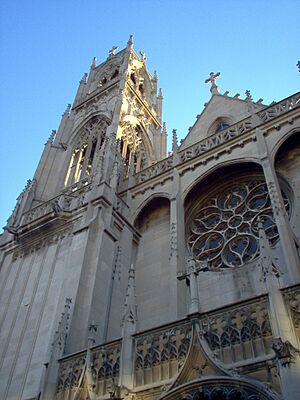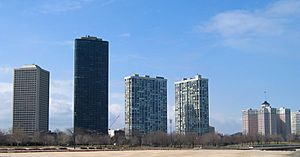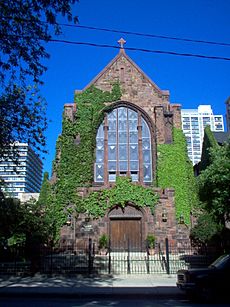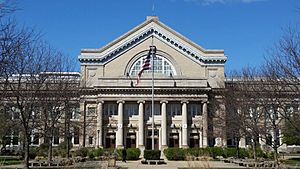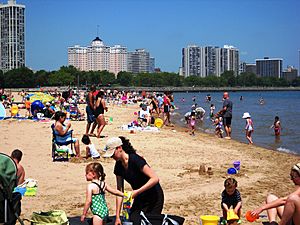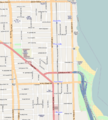Edgewater, Chicago facts for kids
Quick facts for kids
Edgewater
|
|
|---|---|
| Community Area 77 - Edgewater | |
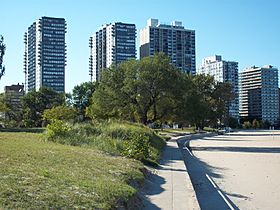
Edgewater, Chicago, Illinois
|
|
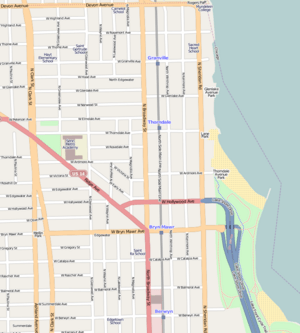
Edgewater, Chicago
|
|
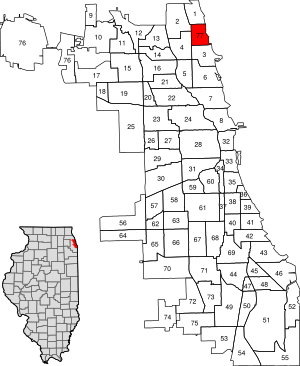
Location within the city of Chicago
|
|
| Country | United States |
| State | Illinois |
| County | Cook |
| City | Chicago |
| Neighborhoods | |
| Area | |
| • Total | 1.71 sq mi (4.43 km2) |
| Population
(2020)
|
|
| • Total | 56,296 |
| • Density | 32,910/sq mi (12,708/km2) |
| Demographics 2019 | |
| • White | 56.6% |
| • Black | 12.3% |
| • Hispanic | 15% |
| • Asian | 12.4% |
| • Other | 3.6% |
| Time zone | UTC-6 (CST) |
| • Summer (DST) | UTC-5 (CDT) |
| ZIP Codes |
60660 and part of 60640
|
| Median income 2019 | $55,768 |
| Source: U.S. Census, Record Information Services | |
Edgewater is a cool neighborhood in Chicago, Illinois. It's right on the shore of Lake Michigan. This area is about six miles north of downtown Chicago, also known as the Loop. Edgewater is one of Chicago's 77 official community areas. It has several beaches where people can relax and have fun. Chicago's biggest park, Lincoln Park, starts here and stretches for seven miles along the lake.
Edgewater used to be a farming area. In the 1880s, it started to become a place for summer homes for rich families from Chicago. Today, you'll see tall apartment buildings and condos near the lake. Further west, there are more single-family homes and smaller apartment buildings. This area also includes the historic village of Andersonville, which is now a busy shopping district.
Contents
Edgewater's Story: A Look Back
How Edgewater Began
In the 1880s, people started buying up farms and cutting down thick woods in Lake View Township. Edgewater was part of this township. The population grew a lot, from 2,000 to 45,000 people in just 17 years! Because of this growth, the area needed more public services. So, in 1889, Lake View Township became part of the city of Chicago.
In 1885, a man named John Lewis Cochran gave the name Edgewater to this part of Lake View. He built the first homes here. Many of his original houses can still be seen in the Lakewood Balmoral Historic District. Edgewater quickly became known as a modern place. It was even called "the only electric lighted suburb adjacent to Chicago."
Street Names: A Philadelphia Connection
John Lewis Cochran was a tobacco salesman from Philadelphia. When he moved to Edgewater, he brought some of his old city's culture with him. This is why many streets in Edgewater are named after train stations from a famous railroad line in Pennsylvania. Some of these streets still have those names today:
- Ardmore Avenue (5800 N), named after Ardmore, PA.
- Thorndale Avenue (5900 N), named after Thorndale, PA. This also became a CTA train station.
- Bryn Mawr Avenue (5600 N), named after Bryn Mawr, PA. This also became a CTA train station.
- Berwyn Avenue (5300 N), named after Berwyn, PA. This also became a CTA train station.
- Devon Avenue (6400 N), named after Devon, PA.
- Rosemont Avenue (6300 N), named after Rosemont, PA.
- Wayne Avenue (1432 W), named after Wayne, PA.
Edgewater in the Early 1900s
By the early 1900s, Edgewater was a very popular and fancy place in Chicago. Huge mansions lined the lakefront. Large single-family homes spread further inland to the area known as Andersonville. A famous building from this time was the Edgewater Beach Hotel. It opened in 1916. This yellow hotel was taken down in 1970. But the pink Edgewater Beach Apartments building is still there. It's a landmark at the north end of Lake Shore Drive.
Around 1900, Edgewater grew so much that part of it was renamed Uptown. Uptown quickly became a busy center for shopping and entertainment. So, when Chicago first named its "Community Areas," Edgewater was included as part of Uptown.
Edgewater's Comeback
In the 1950s, Uptown became less popular as new suburbs grew. Some families moved away, and parts of the area started to look run down. But in the 1970s, many new high-rise condo buildings were built along Edgewater's lakefront. Also, Andersonville started to highlight its unique history.
In 1980, the Chicago City Council and local businesses worked together to bring Edgewater back to life. Edgewater became its own community again, separate from Uptown. New businesses opened, old buildings were fixed up, and homes were improved. Since 2000, new condo buildings like The Clarovista and Catalpa Gardens have been added. Edgewater is also known for its antique shops, like the Broadway Antique Market.
Edgewater's Neighborhoods
Edgewater has several smaller neighborhoods inside it. Andersonville is in the southwest. North of Andersonville are Magnolia Glen and Edgewater Glen. Edgewater Beach is on the eastern side, right by the lake.
Andersonville
Andersonville is a neighborhood in western Edgewater. It was once a quiet village where many Swedish immigrants lived. Today, it's known for being very diverse. It still has a strong Swedish culture, with the Swedish American Museum and Swedish businesses. For example, Simon's Tavern, a former secret bar, serves a Swedish drink called glögg. At one time, more Swedes lived in Chicago than in any city outside of Stockholm, Sweden! Many Swedish immigrants were builders and helped construct the city.
Andersonville also has many Middle-Eastern businesses. Plus, lots of new families with children are moving in. This makes it a very mixed and interesting place. Andersonville is famous for its unique shopping area. It's mostly made up of small, independent shops, restaurants, and service providers.
The Andersonville Commercial Historic District was added to the National Register of Historic Places in 2010. This means it's a special place with important history. It joins the nearby residential Lakewood Balmoral Historic District.
The main streets of Andersonville are Clark and Berwyn. The area stretches from Lawrence (4800 N) to Victoria (5800 N) and from Ravenswood (1800 W) to Magnolia (1250 W).
Andersonville's history goes way back to the 1800s. Swedish farmers started moving north into what was then a distant part of Chicago. After the Great Chicago Fire in 1871, wooden homes were not allowed in Chicago. So, Swedish immigrants, who couldn't afford stone or brick homes, moved outside the city limits. They settled in new homes around Clark Street. Soon, the whole shopping street was filled with Swedish businesses.
Over time, Swedes began to move to the suburbs. The neighborhood started to decline. To help, the local business group changed its name to the Andersonville Chamber of Commerce. In 1964, Andersonville was rededicated in a special ceremony. Around the same time, the Swedish summer festival, Midsommarfest, grew into one of Chicago's biggest street festivals.
Even as some Swedish businesses closed, many stayed. They served both Swedish families and new people moving into the neighborhood. In 1976, the Swedish American Museum opened. The King of Sweden, Carl XVI Gustaf, was there for the opening!
In the late 1980s, Andersonville started to become popular again. Many people discovered its nice homes and its closeness to the lake. New shops and restaurants opened, bringing new life to Clark Street. Today, Andersonville is a vibrant community. It has a strong Swedish culture, diverse residents, and many unique businesses.
Edgewater Glen
Edgewater Glen is in the north-central part of Edgewater. It got its name from Glenwood Avenue and Glenlake Avenue, which cross in the middle of the neighborhood. A group of local residents and businesses, called the Edgewater Glen Association (EGA), created the name in 1972. This group is still active today. The EGA set the boundaries for Edgewater Glen. These are Granville Avenue to the north, Broadway Avenue to the east, Norwood Street to the south, and Clark Street to the west.
The EGA organizes many events for the neighborhood. These include public meetings with local leaders, plant swaps, and the Edgewater Yard Sale. They also host the EGA Garden Walk, which celebrated its 50th anniversary in 2023.
The EGA also works to protect the trees in Edgewater. They keep track of trees and help plant new ones. In 2022, they studied the "heritage trees" (trees 50 years or older) in Edgewater Glen. They also created a guide for other groups to find and track old trees. An exhibit about this project was held at the Edgewater Historical Society in 2023.
Broadway Street
Broadway is a main street that runs north and south through Edgewater. It's like a dividing line. To the east is the Edgewater Beach area, with its tall buildings. To the west are Andersonville and Edgewater Glen, with more single-family homes. In the 1920s, Broadway was a center for car dealerships. Today, it's still a busy commercial street. You can find many different kinds of restaurants here, including Ethiopian, French, Japanese, Thai, and American food. There are also pubs, fast food, and pizza places.
Sheridan Road and Edgewater Beach
Sheridan Road runs along the lakefront in eastern Edgewater. It's a main road for cars coming to and from Lake Shore Drive. Lake Shore Drive ends at Hollywood Avenue, where traffic goes onto Hollywood Avenue or Sheridan Road. This area can get busy with traffic. The neighborhood around Sheridan Road, west to Broadway Avenue, is called Edgewater Beach. The local beaches are Foster Beach and Osterman (Hollywood) Beach. This area also includes the northern part of Lincoln Park, which is Chicago's largest public park.
North of Ardmore Avenue to Devon Avenue, there are four parks along the lake. These include Osterman (Hollywood) Beach, George Lane Park, Berger Park, and a new park near Granville. There's also a park at Thorndale and Sheridan.
Sheridan Road in Edgewater is lined with tall, old locust trees. It's a busy area with many high-rise apartment buildings on both sides. Some of these buildings include Park Edgewater Condominiums, Hollywood Towers, and The Malibu. Many of these towers were built from the late 1950s to the early 1970s.
A few old mansions from the 1880s to 1920s are still left on Sheridan Road. Many of the original lakefront mansions were taken down to make way for the high-rise buildings. But some notable ones remain, like Colvin House and Sacred Heart School. Also, two mansions belong to nearby Loyola University Chicago.
Diverse Communities
Edgewater has become a home for many different kinds of people. Since the 1990s, the number of diverse families has grown. Some people moved here from other neighborhoods like Lakeview and Lincoln Park because Edgewater offered more affordable housing. Businesses that support different groups of people have also opened in Andersonville.
Edgewater is known for being a welcoming place for everyone. In 2012, a real estate website called Trulia named Edgewater as one of the most welcoming neighborhoods in America. In 2017, Trulia and a dating website said Edgewater had a very high percentage of single people who identify as gay, even more than other well-known areas.
International Community
Over the past 20 years, many new residents have moved to Edgewater. They like that it's close to Chicago's lakefront and has easy access to the Red Line train. Many of these new residents are immigrants from the Horn of Africa and the former Yugoslavia. This area has a lot of Bosnian, Serb, and Croat residents. These people, who faced difficult times in their home countries, have found a new home here. Ethiopians, Eritreans, and Somalis also live and socialize in Edgewater. Chicago has a long history of welcoming new groups of people, and this is a modern example of that tradition. Many new residents also come from nearby Lakeview and Lincoln Park. They appreciate the affordable homes and easy train access to downtown Chicago. In Edgewater, you can see people in traditional clothing and grandmothers walking with their grandchildren.
Learning in Edgewater
Edgewater has several Chicago Public Schools (CPS). The local public high school is Nicholas Senn High School, which opened in 1913. Also, four of the neighborhood's elementary schools—Hayt, Swift, Peirce, and Goudy—were rated "excellent" by CPS in 2013. These schools help prepare students for Senn High School.
There are also several Catholic and other religious schools in the neighborhood. The Edgewater Branch of the Chicago Public Library serves the area. The nearby Bezazian Branch in Uptown also helps people in Edgewater.
Loyola University of Chicago's campus is right next to northeastern Edgewater. The college started on the lakefront in 1906.
Getting Around Edgewater
Most people in Edgewater use public transportation provided by the Chicago Transit Authority. The Red Line train is a major way to get around. It runs north to the city limits and south to places like Wrigley Field, downtown Chicago, and Rate Field. Edgewater has four Red Line stations: Berwyn, Bryn Mawr, Thorndale, and Granville.
Along Edgewater's western edge are the train tracks for Metra's North Line. This train can take you downtown or to Chicago's northern suburbs.
The Chicago Transit Authority also runs many bus routes in Edgewater. Some buses go along North Lake Shore Drive and offer express service to downtown Chicago.
You can also find other ways to get around. There are car-sharing services like I-GO and Zipcar. You can also use bicycle-sharing services like Divvy. Taxis and limousines are easy to find. In the summer, you can rent Bicycles and rickshaws near Foster Beach. There are also bike paths on some main streets. Plus, there are nice walking and running paths near the lake, including the Chicago Lakefront Trail, which is popular with bike commuters.
Famous People from Edgewater
- Ian Barford (born 1966), an actor who lives in Andersonville.
- Hillary Clinton (born 1947), who was the 67th United States Secretary of State. Her family lived in Edgewater until she was three years old.
- Lucas Neff (born 1985), an actor famous for his role in Raising Hope. He grew up in Andersonville.
- Ken Nordine (1921-2019), a poet and recording artist. He lived in Edgewater from 1951 until he passed away. His old home was given preliminary historic status in 2020.
- Anna D. Shapiro (born 1966), a theater director and professor who lives in Andersonville.
- Harold Ramis (1944-2014), an actor, writer, and director. He went to Stephen K. Hayt Elementary School and Nicholas Senn High School in Edgewater.
Images for kids


